Leopold II (1835-1909) – Koning der Belgen
Leopold II was the second king of the Belgians, reigning from 1865 to 1909. He was born on April 9, 1835, in Brussels, Belgium. Leopold II was the eldest son of King Leopold I and Queen Louise-Marie of Belgium. The young prince was educated at home and later attended the Military School in Brussels. He became king at the age of 30, following the death of his father, King Leopold I, in 1865.
Leopold II’s reign was marked by his involvement in the colonization of Africa, particularly the Congo Free State. He is widely remembered for his brutal and exploitative treatment of the Congolese people during his rule over the region. Leopold II’s legacy in Africa is still a topic of debate and controversy to this day.
Early Life and Rise to the Throne
Leopold II was born on April 9, 1835, in Brussels, Belgium. His father, King Leopold I, was the first king of the Belgians, having ascended to the throne in 1831. His mother, Queen Louise-Marie, was the daughter of King Louis Philippe of France.
Leopold II was the eldest of four children. He had two younger brothers, Prince Philippe and Prince Henri, and a younger sister, Princess Charlotte. Leopold was educated at home by private tutors and later attended the Military School in Brussels. He served in the Belgian army for a brief period before being appointed as a member of the Belgian Senate in 1855.
In 1865, King Leopold I died, and Leopold II ascended to the throne as the second king of the Belgians. He was 30 years old at the time and was known for his reserved and introverted personality.
Leopold II’s Reign
Leopold II’s reign was marked by his involvement in the colonization of Africa, particularly the Congo Free State. In 1876, Leopold formed the International African Association, which aimed to promote exploration and trade in Africa. He used the association to further his own interests in the region and to gain control of the Congo.
In 1884, Leopold formed the Congo Free State, which was granted to him as a personal possession by the Berlin Conference of 1884-1885. The Congo Free State was run as a private enterprise, with Leopold as its sole owner. He used the territory to extract ivory and rubber, often through brutal means. The Congolese people were forced to work long hours under harsh conditions and were subject to brutal punishments for failing to meet production quotas.
Leopold’s rule over the Congo Free State was characterized by extreme violence and exploitation. The Congolese people were subjected to forced labor, beatings, and other forms of violence. Millions of people died as a result of Leopold’s policies, either from starvation, disease, or violence.
Leopold’s legacy in Africa is still a topic of debate and controversy to this day. While some argue that he played a significant role in the development of the Congo, others argue that his actions were motivated solely by greed and exploitation.
Conclusion
Leopold II was the second king of the Belgians, reigning from 1865 to 1909. His reign was marked by his involvement in the colonization of Africa, particularly the Congo Free State. Leopold’s legacy in Africa is still a topic of debate and controversy to this day, with some arguing that he played a significant role in the development of the Congo, while others argue that his actions were motivated solely by greed and exploitation.
FAQs
1. What was Leopold II’s involvement in Africa?
Leopold II was involved in the colonization of Africa, particularly the Congo Free State. He used the territory to extract ivory and rubber, often through brutal means. The Congolese people were forced to work long hours under harsh conditions and were subject to brutal punishments for failing to meet production quotas.
2. What was Leopold II’s legacy in Africa?
Leopold’s legacy in Africa is still a topic of debate and controversy to this day. While some argue that he played a significant role in the development of the Congo, others argue that his actions were motivated solely by greed and exploitation.
3. What was the International African Association?
The International African Association was formed by Leopold II in 1876. It aimed to promote exploration and trade in Africa and was used by Leopold to further his own interests in the region and to gain control of the Congo.
4. What was the Congo Free State?
The Congo Free State was formed by Leopold II in 1884. It was granted to him as a personal possession by the Berlin Conference of 1884-1885. The Congo Free State was run as a private enterprise, with Leopold as its sole owner.
5. What were the conditions like for the Congolese people under Leopold II’s rule?
The Congolese people were subjected to forced labor, beatings, and other forms of violence under Leopold II’s rule. Millions of people died as a result of his policies, either from starvation, disease, or violence.
